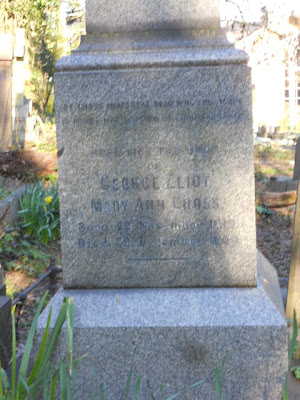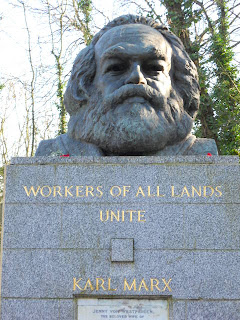Douglas Adams, author of Hitchikers Guide to the Galaxy.
George Eliot, the name adopted by Mary Ann Evans, one of the most celebrated novelists of the Victorian period.
Having snapped these I stumbled upon these I made my way to the collosal grave of Marx himself.
The grave itself is quite interesting. Until 1954 the site was marked by a fairly humble gravestone which was then replaced by the current monument (at least 9 foot from base to the top of the bust) by the Communist Party of Great Britain. There was an attempt to destroy it by right-wing anti-communists in 1970. A stroll around the base also revealed the visit of some interesting mourners.
An Italian edition of the communist manifesto next to a handwritten note. Unfortunately, I can't speak Italian so it's contents remain a mystery.
Flowers at the graveside.
Left by our old friends the Maoists.
It was the graves that were given the honour of proximity to Marx that proved most interesting though. I honestly don't know how one ensures that their grave is located in this particular part of an already overcrowded cemetery. Personally, I reckon it would require a fairly substantial donation to the Friends of Highgate Cemetery and a certain degree of reputation. Anyway, that's just speculation. If anyone knows the process it's be interesting to know. Not that I'm intending to be buried in Highgate, just curious :). Anyway on to Marx's neighbours.
Chris Harman. Leading theorist and central committee member of the British SWP. Editor of numerous publications and responsible for a slew of theoretical material.
Buried nearby is his comrade Paul Foot, writer and journalist. Perhaps best known for his campaigning work on behalf of the Birmingham 6.
Mansoor Hekmat. Founder of the Worker-Communist Movement whose main strength has been in Iran and Iraq. An interesting figure, revered within the Iranian party. His ideas are interesting in representing one of the few significant variants of anti-Stalinist Marxism besides Trotskyism.
Yusuf and Winifred Dadoo, South African communist leaders.
Koque Martinez
Nazhad Agha. Deputy leader of the parliament of Kurdistan. Originally established after the first gulf war.
Buland Al Haidari. Kurdish poet and activist.
Saad Saadi Ali. Iraqi Communist Leader.
Another Iraqi Communist. The proliferation of Iraqi and Kurdish graves is interesting. Perhaps due largely to the fact that many of them lived in exile in London during Hussein's rule.
Well that's pretty much it. I might do similar articles on other 'political' graveyards closer to home (like Bodenstown) the next time I have a chance. There's clearly a lot of work to be done on these kind of cemeteries in relation to popular memory and so on.

















No comments:
Post a Comment